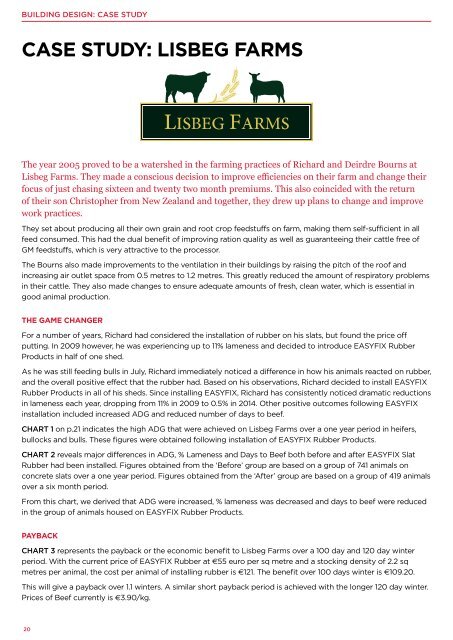EF-EASYFIX-Dairy-Beef-Product-Catalogue-2016-REPRINT-141116
Create successful ePaper yourself
Turn your PDF publications into a flip-book with our unique Google optimized e-Paper software.
BUILDING DESIGN: CASE STUDY<br />
CASE STUDY: LISBEG FARMS<br />
The year 2005 proved to be a watershed in the farming practices of Richard and Deirdre Bourns at<br />
Lisbeg Farms. They made a conscious decision to improve efficiencies on their farm and change their<br />
focus of just chasing sixteen and twenty two month premiums. This also coincided with the return<br />
of their son Christopher from New Zealand and together, they drew up plans to change and improve<br />
work practices.<br />
They set about producing all their own grain and root crop feedstuffs on farm, making them self-sufficient in all<br />
feed consumed. This had the dual benefit of improving ration quality as well as guaranteeing their cattle free of<br />
GM feedstuffs, which is very attractive to the processor.<br />
The Bourns also made improvements to the ventilation in their buildings by raising the pitch of the roof and<br />
increasing air outlet space from 0.5 metres to 1.2 metres. This greatly reduced the amount of respiratory problems<br />
in their cattle. They also made changes to ensure adequate amounts of fresh, clean water, which is essential in<br />
good animal production.<br />
THE GAME CHANGER<br />
For a number of years, Richard had considered the installation of rubber on his slats, but found the price off<br />
putting. In 2009 however, he was experiencing up to 11% lameness and decided to introduce <strong>EASYFIX</strong> Rubber<br />
<strong>Product</strong>s in half of one shed.<br />
As he was still feeding bulls in July, Richard immediately noticed a difference in how his animals reacted on rubber,<br />
and the overall positive effect that the rubber had. Based on his observations, Richard decided to install <strong>EASYFIX</strong><br />
Rubber <strong>Product</strong>s in all of his sheds. Since installing <strong>EASYFIX</strong>, Richard has consistently noticed dramatic reductions<br />
in lameness each year, dropping from 11% in 2009 to 0.5% in 2014. Other positive outcomes following <strong>EASYFIX</strong><br />
installation included increased ADG and reduced number of days to beef.<br />
CHART 1 on p.21 indicates the high ADG that were achieved on Lisbeg Farms over a one year period in heifers,<br />
bullocks and bulls. These figures were obtained following installation of <strong>EASYFIX</strong> Rubber <strong>Product</strong>s.<br />
CHART 2 reveals major differences in ADG, % Lameness and Days to <strong>Beef</strong> both before and after <strong>EASYFIX</strong> Slat<br />
Rubber had been installed. Figures obtained from the ‘Before’ group are based on a group of 741 animals on<br />
concrete slats over a one year period. Figures obtained from the ‘After’ group are based on a group of 419 animals<br />
over a six month period.<br />
From this chart, we derived that ADG were increased, % lameness was decreased and days to beef were reduced<br />
in the group of animals housed on <strong>EASYFIX</strong> Rubber <strong>Product</strong>s.<br />
PAYBACK<br />
CHART 3 represents the payback or the economic benefit to Lisbeg Farms over a 100 day and 120 day winter<br />
period. With the current price of <strong>EASYFIX</strong> Rubber at €55 euro per sq metre and a stocking density of 2.2 sq<br />
metres per animal, the cost per animal of installing rubber is €121. The benefit over 100 days winter is €109.20.<br />
This will give a payback over 1.1 winters. A similar short payback period is achieved with the longer 120 day winter.<br />
Prices of <strong>Beef</strong> currently is €3.90/kg.<br />
20


